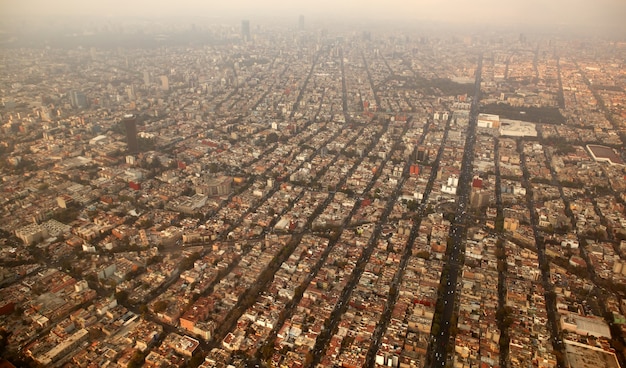Reducing Air Pollution: A Science-Based Strategy for US Cities

Exploring the science of air pollution reveals that US cities can reduce particulate matter levels by 10% in the next three years through targeted strategies focusing on emissions control, technological innovation, and community engagement.
The air we breathe in urban environments is often laden with pollutants, posing significant health risks. Can US cities realistically cut down particulate matter by 10% in just three years? This article delves into exploring the science of air pollution: how can US cities reduce particulate matter levels by 10% in the next three years?, examining strategies and challenges along the way.
Understanding Particulate Matter and Its Impact
Particulate matter (PM) is a complex mixture of extremely small particles and liquid droplets. These particles can be made up of hundreds of different chemicals. Understanding their size, composition, and sources is crucial for developing effective reduction strategies.
The impact of particulate matter on human health is profound, ranging from respiratory issues to cardiovascular diseases. Let’s explore the types of PM and why they’re harmful.
Types of Particulate Matter
Particulate matter is generally categorized into two main size fractions: PM10 and PM2.5. PM10 includes particles with a diameter of 10 micrometers or less, while PM2.5 consists of even finer particles, with a diameter of 2.5 micrometers or less.
Health Risks Associated with PM
Exposure to PM, especially PM2.5, can lead to a variety of health problems. These particles can penetrate deep into the lungs and even enter the bloodstream. The risks include respiratory infections, asthma exacerbation, heart attacks, and strokes.
- Respiratory Issues: PM can irritate the airways and trigger coughing, wheezing, and shortness of breath.
- Cardiovascular Diseases: Fine particles can contribute to the development of heart disease and increase the risk of heart attacks.
- Increased Hospitalizations: Elevated PM levels often correlate with increased hospital admissions for respiratory and cardiovascular conditions.
- Premature Mortality: Long-term exposure to PM has been linked to a reduced lifespan.

Reducing particulate matter is not just an environmental goal; it’s a public health imperative, critical for the well-being of urban populations.
Identifying Major Sources of Particulate Matter in US Cities
To effectively reduce particulate matter, we must first understand where it is coming from. Identifying the primary sources allows for targeted interventions and policies.
Various sectors contribute to PM emissions, but some are more critical than others. Let’s highlight transportation, industrial activities, and residential heating.
Transportation Emissions
Vehicles, including cars, trucks, and buses, emit PM through tailpipe emissions and tire and brake wear. The composition of these emissions can vary depending on the type of vehicle and fuel used.
Industrial Activities
Manufacturing plants, power generation facilities, and construction sites release PM into the atmosphere. These emissions can include a wide range of pollutants, depending on the specific industrial processes.
Residential Heating
Burning wood, coal, and other fuels for heating purposes can be a significant source of PM, especially during the colder months. Inefficient heating systems can exacerbate the problem.
Understanding these sources helps in designing effective strategies, to reduce PM levels in US cities.
Strategies for Reducing Transportation-Related PM
Transportation is a major contributor to particulate matter in many US cities. Implementing strategies to reduce emissions from vehicles is essential for meeting air quality targets.
Strategies include promoting electric vehicles, improving public transportation, and implementing stricter emissions standards are crucial steps. How do these initiatives reduce pollution?
Promoting Electric Vehicles (EVs)
Transitioning to electric vehicles can significantly reduce tailpipe emissions. Incentives, such as tax credits and rebates, can encourage consumers to adopt EVs.
Improving Public Transportation
Investing in public transportation can reduce the number of vehicles on the road. Expanding bus and train networks can offer convenient alternatives to driving.
Stricter Emissions Standards
Implementing stricter emissions standards for vehicles can reduce the amount of PM released. Regular vehicle inspections can help ensure compliance with these standards.
- Incentivize EV Adoption: Offer financial incentives to make EVs more affordable.
- Expand Public Transit: Invest in reliable and accessible public transportation options.
- Enforce Emission Standards: Regularly inspect vehicles to ensure they meet emission standards.
- Promote Cycling and Walking: Create safe infrastructure for cyclists and pedestrians.
By focusing on transportation-related strategies, cities can make significant strides in reducing particulate matter and improving air quality for their residents.
Mitigating PM Emissions from Industrial Sources
Industrial activities are another significant source of particulate matter in urban areas. Implementing measures to reduce emissions from these sources is crucial for achieving cleaner air.
Strategies include adopting cleaner technologies, improving pollution control equipment and enforcing environmental regulations are essential. But how do these improve air quality?
Adopting Cleaner Technologies
Encouraging industries to adopt cleaner technologies can significantly reduce PM emissions. This may involve switching to less polluting fuels or upgrading equipment.
Improving Pollution Control Equipment
Installing and maintaining effective pollution control equipment, such as scrubbers and filters, can capture PM before it is released into the atmosphere.
Enforcing Environmental Regulations
Strict enforcement of environmental regulations can ensure that industries comply with emission limits. Regular inspections and penalties for non-compliance can deter violations.

Through consistent enforcement and technological upgrades, US cities can effectively reduce PM emissions from industrial sources.
Addressing PM from Residential Heating and Other Sources
Residential heating, particularly the burning of wood and other solid fuels, can contribute to particulate matter pollution, especially during the winter months. Addressing these emissions is essential for a comprehensive air quality strategy.
Solutions can promoting cleaner heating alternatives, improving building insulation, and educating residents about responsible burning practices are vital. How can these strategies be executed?
Promoting Cleaner Heating Alternatives
Incentivizing the use of cleaner heating alternatives, such as natural gas or electric heat pumps, can reduce PM emissions. Offering rebates or subsidies can make these options more affordable.
Improving Building Insulation
Improving building insulation can reduce the need for heating, thereby decreasing PM emissions. Weatherization programs can help residents improve their home’s energy efficiency.
Educating Residents
Educating residents about responsible burning practices can also help reduce PM emissions. This includes using only dry, seasoned wood and avoiding burning on high-pollution days.
Community engagement and simple changes can create cleaner, healthier air for everyone.
Monitoring and Evaluating Progress Towards the 10% Reduction Goal
Effective monitoring and evaluation are critical for tracking progress towards the goal of reducing particulate matter levels by 10% in three years. Establishing a robust monitoring network and regularly analyzing data are essential steps.
Regularly assessing data allows adjustments and refinement to the overall reduction strategy to be made as needed. Here’s how monitoring can enhance air-quality.
Establishing a Monitoring Network
Deploying a network of air quality monitors throughout the city can provide real-time data on PM levels. These monitors should be strategically placed to capture pollution hotspots.
Analyzing Data Regularly
Analyzing the data collected by the monitoring network can help identify trends and assess the effectiveness of intervention strategies. This analysis should be conducted regularly to inform decision-making.
Adjusting Strategies as Needed
Based on the monitoring data, cities can adjust their strategies to maximize their impact. This may involve reallocating resources or implementing new policies.
Continuous assessment is pivotal for refining methods, ensuring the sustainability of positive pollution reduction outcomes.
| Key Point | Brief Description |
|---|---|
| 🚗 EV Promotion | Incentivizing electric vehicle adoption to reduce tailpipe emissions. |
| 🏭 Industrial Tech | Upgrading to cleaner technologies in industries to reduce emissions. |
| 🏠 Heating Alternatives | Promoting cleaner residential heating to cut down PM emissions. |
| 📊 Data Analysis | Regularly analyzing air quality data to refine strategies and ensure effectiveness. |
Frequently Asked Questions (FAQ)
▼
Particulate matter consists of tiny particles and liquid droplets in the air, composed of various chemicals that can be harmful when inhaled.
▼
PM2.5 is smaller and can penetrate deeper into the lungs and bloodstream, leading to more severe health problems than the larger PM10 particles.
▼
Electric vehicles produce zero tailpipe emissions, reducing the amount of particulate matter released into the air compared to gasoline-powered vehicles.
▼
Individuals can use public transportation, drive less, switch to cleaner heating options, and support policies that promote cleaner air quality.
▼
Air quality is monitored using a network of air quality monitors that measure the levels of different pollutants, including particulate matter, in real-time.
Conclusion
Reducing particulate matter in US cities by 10% in the next three years is an ambitious but achievable goal. By implementing targeted strategies across multiple sectors, embracing technological advancements, promoting community engagement, and continuously monitoring progress, cities can create cleaner, healthier environments for their residents.





